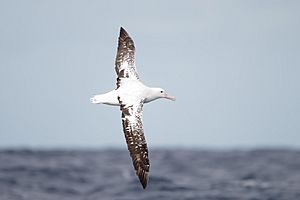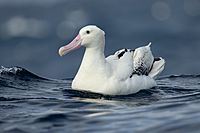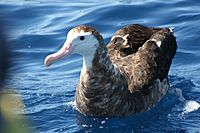Gibson's albatross facts for kids
Quick facts for kids Gibson's albatross |
|
|---|---|
 |
|
| In flight off south-eastern Tasmania | |
| Conservation status | |
| Scientific classification |
|
| Kingdom: | Animalia |
| Phylum: | Chordata |
| Class: | Aves |
| Order: | Procellariiformes |
| Family: | Diomedeidae |
| Genus: | Diomedea |
| Species: | |
| Subspecies: |
D. a. gibsoni
|
| Trinomial name | |
| Diomedea antipodensis gibsoni Robertson & Warham, 1992
|
|
| Synonyms | |
|
|
The Gibson's albatross (Diomedea antipodensis gibsoni) is a very large seabird. It belongs to the group of birds called the great albatrosses, which are part of the albatross family. This amazing bird is also known as the Auckland Islands wandering albatross or Gibson's wandering albatross.
The name "Gibson's albatross" honors John Douglas Gibson. He was an Australian amateur ornithologist, which means he studied birds. John Gibson spent 30 years studying albatrosses off the coast of New South Wales.
Contents
About Gibson's Albatross
Scientists often group animals into different categories. The Gibson's albatross is usually seen as a subspecies of the Antipodean albatross. This means it's a specific type within that larger group.
Some scientists think the Antipodean albatross itself is a type of wandering albatross. Others believe the Gibson's albatross is its own full species, called Diomedea gibsoni. It's a bit like different ways of organizing a big family tree!
What Does It Look Like?

The Gibson's albatross looks a lot like the wandering albatross. Adult birds have white feathers on their back. This white color also spreads along the upper part of their wings, close to their body. Their head and body are mostly white, but they have thin grey lines.
The upper part of their wings has a black edge at the back. Their flight feathers are black, and they have white patches mixed with black on the main wing feathers. The underside of their wings is white with a dark edge. Their tail is white with black edges, but older males might have a completely white tail. The bill, which is their beak, is a light pink color.
Female Gibson's albatrosses are usually a bit smaller and their colors are not as bright as the males. Adult males weigh about 6.8 kilograms (15 pounds). Females are lighter, weighing around 5.8 kilograms (12.8 pounds).
Where Do They Live?
Gibson's albatrosses only breed in the subantarctic Auckland Islands. This is a group of islands in New Zealand.
When they are breeding, female albatrosses mostly find food in the Tasman Sea. Males travel further south to find food. They forage in the southern parts of the Southern Ocean, between 30° and 50° South latitude. This area includes the Roaring Forties, where strong winds help them fly easily to find food.
Even though they might fly as far south as the edge of the Antarctic pack-ice in late summer, they rarely go south of the Antarctic Convergence in winter.
Behaviour and Life Cycle
Nesting and Reproduction
On their breeding islands, Gibson's albatrosses build their nests on mossy areas and in tussock grassland. They choose spots on or near ridges, slopes, and flat areas. They like exposed, windy places because it helps them take off into flight. They often form small groups, called colonies, on the windy sides of the islands.
These albatrosses breed only every two years, if they are successful. Studies in the 1990s showed that about 67% of pairs successfully bred each year. Albatross pairs come back to their breeding islands starting in November. The older males are usually the first to arrive.
They build a raised nest out of mud for their single chick. The egg is laid in late December or early January. The female builds most of the nest, while the male gathers the materials. Both parents take turns sitting on the egg to keep it warm. They take long shifts, usually two to three weeks each. The male takes the first shift. While one parent is incubating, the other flies off to find food. They often travel far, sometimes up to 1000–1500 kilometers (620–930 miles) away in the Tasman Sea.
The egg usually hatches in early March, after about 78 days of incubation. Both parents take turns brooding the chick for about four or five weeks. After that, they visit the chick at different times throughout the winter. It takes a long time for the chick to grow and be ready to fly. This period, from hatching to fledging (when it first flies), lasts about 278 days. Chicks usually fledge from mid-November to mid-December.
Finding Food
These albatrosses find their food in the open ocean, which is called the Pelagic zone. They eat fish, cephalopods (like squid and octopus), and crustaceans (like crabs and shrimp).
They usually catch food from the sea surface or just below it. They can also make shallow dives from heights of 2–5 meters (6.5–16 feet). When they fly, they stay within 15 meters (50 feet) of the water. They use the air currents that rise from waves to help them fly. This helps them travel long distances to search for food. They often follow fishing boats to find leftover fish or to grab bait.
Status and Conservation
Population Numbers
There are about 40,000 Gibson's albatrosses in the world. In 1999, scientists estimated there were about 10,000 breeding pairs.
Research on Adams Island in the 1990s showed that about 98% of adult males and 96% of adult females survived each year. Between 1991 and 1997, about 5,831 pairs bred each year in the Auckland Islands. Most of these bred on predator-free Adams Island. Only 65 pairs bred on the main Auckland Island, which has introduced animals like mice, feral cats, and pigs. About 250 pairs bred on the smaller Disappointment Island.
Sadly, the number of Gibson's albatrosses has gone down. In 1973, there were an estimated 20,000 breeding pairs, and probably even more in the 1800s. Between 1997 and 2009, their numbers dropped by about 40%. The survival rate of adults and the number of new birds joining the population also decreased.
Threats to Their Survival
In the 1800s, people visiting the Auckland Islands sometimes collected albatross eggs without control. This stopped a long time ago. However, since the mid-1900s, the albatross population has faced new dangers.
One major threat is from longline fishing in the Southern Ocean. Albatrosses looking for food can get hooked or tangled in fishing lines and drown. This is called "bycatch."
Other dangers include:
- Plastic pollution: Albatrosses can eat floating plastic debris, which can make them starve.
- Human disturbance: People getting too close to their nesting sites can disturb them.
- Introduced predators: There's a risk of new animals like rodents being accidentally brought to their nesting islands. These animals could harm the albatrosses or their eggs.
- Climate change: Changes in the climate could affect their habitat.
Because of these threats, the Gibson's albatross is listed as a vulnerable species. This means it is at risk of becoming endangered if these problems are not fixed. It is protected under Australia's Environment Protection and Biodiversity Conservation Act 1999.




